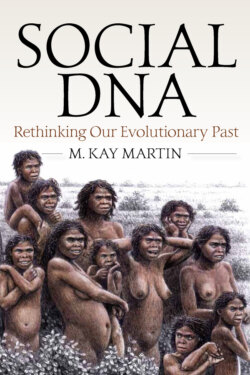Читать книгу Social DNA - M. Kay Martin - Страница 22
На сайте Литреса книга снята с продажи.
Complementarity and Cooperation
ОглавлениеAn alternative perspective on the social consequences of anisogamy is that selective pressures favored the evolution of disparate but complementary behaviors among the sexes within the context of cooperative breeding communities. This theoretical framework assumes that both males and females are active players, each pursuing their reproductive strategies sexually, politically, and economically, and further, that their mutual reproductive success is enhanced by the creation of collaborative and overlapping alliances.
By the mid 1970s, androcentric theories on human societal origins were being increasingly challenged by the women’s movement, and female scholars began to re-examine prevailing assumptions in the fields of anthropology and primatology.8 Sarah Hrdy, in her seminal work The Woman That Never Evolved (1981), questioned the notion that natural selection had exerted its influence primarily or exclusively on males. The book presented data that challenged existing stereotypes of primate behaviors, which had previously relied largely on observations of male dominance hierarchies and differential male access to estrus females. Women primatologists took to the field, placing primary research emphasis for the first time on the sexual and social lives of females. The results of these studies literally transformed our understanding of primate breeding systems (Small 1984, 1993).
What researchers discovered is that female primates are far from the coy, asexual, demure, and parasitized creatures some portrayed them to be. Instead, they are often sexually aggressive, actively seeking the novelty and variety of multiple partners while utilizing sex to create strategic alliances that further their reproductive success. Females are also often highly competitive, commonly organizing themselves into stable hierarchies in which status and territories are passed from mother to daughter. These hierarchies may impact access to food resources and, because they have greater stability and permanence than male mating hierarchies, can play a critical role determining the overall social structure of the group. In short, female primates are deliberate and active participants in the game of reproductive success. The strategies of males and females are distinct but interdependent, and rely on an intricate web of same-sex and opposite-sex alliances. What these primate data suggest is that natural selection has exerted its pressures on the sexes from ancient times, both on individuals and on groups within the context of complex social networks that bind the members of a breeding community.
The perception of anisogamy pursued in this book is consistent with this view. Just as the joining of the sperm and egg at conception requires a mutually active partnership, so the evolution of human society required the successful integration of male and female reproductive strategies. In the words of Christopher Ryan and Cacilda Jetha: “There’s no denying that men and women are different, but we’re hardly different species or from different planets or designed to torment one another. In fact, the interlocking nature of our differences testifies to our profound mutuality” (2010: 270).
Models of why and how intersexual partnerships evolved need not be based on notions of conflict, parasitism, dominance, gender stereotypes, or zero-sum games. Rather, human advancement relied more on brains than brawn—that is, on the liberation of males and females from primitive limbic system responses and the corresponding ability to modify their behaviors and structure their alliances in ways that furthered their respective reproductive goals. The next chapter challenges prevailing theories on the nature of proto-human society and offers an alternative model of how ancient multimale-multifemale communities evolved on the basis of cooperative intra- and intersexual alliance.
